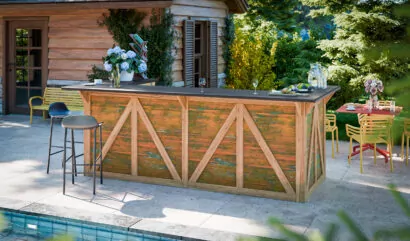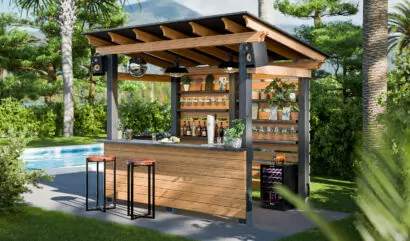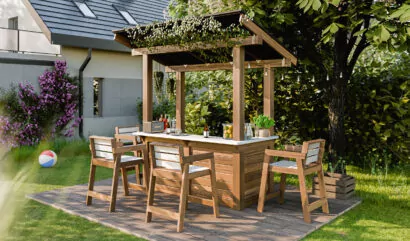Choosing Your Outdoor Bar Plan: A Comprehensive Guide
Just imagine family, friends and neighbors gathering around the perfect outdoor bar. You can welcome guests into a backyard of fun by building this bar yourself!
Whether you’re looking for a simple DIY project or a more elaborate permanent installation, this guide will help you navigate the various options and select the perfect outdoor bar design for your specific needs, space, and budget.
Defining Your Outdoor Bar Goals
The first step in your journey to the outdoor bar of your dreams is to consider what you’ll be using it for. Will you and your family be using it regularly? Will you be hosting gatherings with friends? Are you aspiring for a vacation-inspired oasis that recreates a tropical retreat or do you want a far more casual and informal vibe? Are you creating a space for poolside refreshments near a swimming pool or hot tub? Are you looking for an outdoor dining complement to your existing patio dining setup? Will your bar be part of a complete outdoor cooking setup? Let the answers to these questions guide your outdoor bar plan selection process.
Benefits of an Outdoor Bar
No matter what plan you choose to follow, an outdoor bar can make your backyard gatherings far more enjoyable and memorable. The key practical and aesthetic benefits of a properly designed outdoor bar include:
- Creating a natural gathering spot for socializing
- Providing a designated space for drink preparation and service
- Saving trips to and from the house during parties
- Adding value to your home and outdoor living space
- Extending your living area into the outdoors
Location Considerations
When planning the construction of an outdoor bar, you want to choose a site in your backyard that balances functional convenience and visual appeal with proper protection from the natural elements. Regardless of its location, weatherproofing and regularly maintaining your outdoor bar will help keep it in top condition.
Important location factors to consider include:
- Convenient access to your home
- View considerations (blocking or facing a garden, pool, or other feature)
- Protection from the elements (wind, rain, excessive sun)
- Proximity to utilities (water, electricity)
- Level ground or a plan to accommodate slopes
- Privacy from neighbors if desired
Sizing Your Outdoor Bar
Take stock of how many people you typically entertain and how much space you have in your backyard.
Here are just a few guidelines to ensure that your outdoor bar is just the right size:
- While bar heights can vary to suit individual needs, the standard bar height is 42 inches.
- To promote comfortable use, a bar should be 24 to 30 inches deep.
- Bar length is only limited by available space, but you should allow at least 24 inches per seated person.
- Allow at least 3 feet behind bar stools for standing room and comfortable movement.
- Consider your use and storage needs to provide enough space for equipment and supplies.
Outdoor Bar Styles and Designs
Rustic Outdoor Bar
A beautiful complement to garden and country-style homes, a rustic outdoor bar incorporates natural wood elements, often with a weathered or reclaimed appearance. These bars tend to have simple designs with minimal embellishment. Their natural wood construction is highly durable and features a warm, earthy color palette.
Modern Outdoor Bar
A modern outdoor bar often features clean lines, geometric shapes, sleek materials, and minimalist design. This style works well with contemporary homes and landscapes. Often made using metal, concrete, stone, and glass materials, these bars generally feature a neutral color palette with occasional bold accents. They also commonly incorporate lighting, refrigeration, and other built-in technology features.
Tropical Tiki Bar
Tiki bars are great for promoting a festive and relaxed atmosphere. They incorporate features like thatched roofs, bamboo accents, and island-inspired decorations like carved wooden tikis, bright colors, and palm fronds. Exotic lighting such as tiki torches or vintage lanterns can complete the tropical feel. Your guests will feel as if they’re on vacation!
Portable/Rolling Bar
A portable bar lends tremendous flexibility to your outdoor space. Many of these lightweight bars roll on wheels to aid in movement. You can also choose a foldable or collapsible design for easy transport and storage. Portable/rolling bars are perfect for people who like to rearrange their setup or have limited permanent space.
Built-in/Permanent Bar
These highly durable structures have a permanent foundation, are integrated with existing outdoor structures, and often include plumbing and electrical fixtures. For those wanting a long-lasting outdoor bar that can withstand the elements for decades, concrete is considered the most durable material, especially when topped with granite or concrete countertops.
Material Options
Wood
Wood is a relatively affordable material option that is generally easy to work with. It has a warm, natural appearance and can be stained or painted to match existing décor. However, it also requires regular maintenance, can rot or warp if not properly treated, is susceptible to insect damage, and has a limited lifespan in harsh natural climates. When building an outdoor wooden bar, use quality materials that are weather-resistant, such as cedar, redwood, or pressure-treated pine. Always drill pilot holes before inserting screws or nails to prevent the wood from splitting.
Metal
Corrugated metal combined with other materials like concrete and cedar creates a durable outdoor bar that stands up well to the elements and requires little routine maintenance because it stands up to weather, insects, and rot. It has a contemporary, industrial look that blends with modern aesthetic sensibilities. Drawbacks of metal outdoor bars include their higher cost and the specialized tools that you might need to build one. They can also rust if not properly treated and become hot to the touch in direct sunlight.
Concrete
Concrete bar tops provide an extremely durable surface that can withstand virtually any outdoor condition while offering a solid, substantial feel. They can be formed into custom shapes with a wide range of colors and finishes. However, they are also extremely heavy, relatively expensive, and can crack if not properly reinforced. Only skilled technicians can install a concrete bar.
Composite and Synthetic Materials
Often made from recycled raw ingredients, modern composite materials offer the look of natural materials with enhanced durability and weather-resistance. But, if they don’t have the right character, they lack the look and feel of the natural materials they mimic. They also offer limited repair options if damaged.
Additional Features to Consider
Roofing Options
Add a roof to your outdoor bar to protect it from the sun and rain. Options include traditional roofing materials like asphalt shingles, but for a more tropical vibe, consider a roof of thatched grass or palm leaves.
Built-in Coolers
Place a built-in cooler in your outdoor bar to keep drinks cold and easily accessible, eliminating trips to the kitchen refrigerator during gatherings.
Storage Solutions
Keep essentials easily accessible with the right storage spaces. Consider a small refrigerator to store perishable supplies.
Lighting
Use your backyard entertainment space after dark and create the right atmosphere for your outdoor bar with proper lighting. Options include overhead lighting for general illumination, task lighting near the bar counter for better visibility, and landscape lighting for accent illumination.
Weather Protection
Beyond incorporating a roof or awning to shield your bar from the elements, you can cover your bar equipment and furniture when not in use.
DIY vs. Pre-Made Options
DIY Advantages
You can build an outdoor bar in just a couple of days, if you use the right materials and tools. DIY allows for complete customization to fit your specific needs, space and style preferences.
Pre-Made Kit Advantages
Pre-made outdoor bar kits provide a complete experience without all the work of trying to build one from scratch. You create your own layout with features such as modular island cabinets and other storage options.
Popular Outdoor Bar Layouts
L-Shaped Bar
An L-shaped or corner bar design can establish dedicated areas for dining and cooking. This versatile layout can incorporate different bar heights and single or double-sided sections.
Straight Bar
A straight bar design is the simplest to construct and works well against walls or fences. It can also divide your outdoor space into distinct sections.
Island Bar
Accessible from any direction, a 360-degree island bar creates a social hub for interactive entertaining.
U-Shaped Bar
Ideal for larger gatherings, U-shaped bars maximize counter and storage space while creating a defined serving area.
Final Planning Tips
- Research local regulations and find out if you’ll need any permits before building your outdoor bar.
- Take your local climate into account and design the bar to handle seasonal weather conditions, especially if you need to shut down the bar during the cold winter months.
- Plan ahead for plumbing and electrical needs to avoid surprises later in the process.
- Choose materials and designs that match the level of maintenance you’re comfortable with.
- Start with a simple setup and keep in mind that you can always expand or upgrade over time.
By carefully considering these factors, you can select the outdoor bar plan that best suits your space, entertainment style, and personal preferences. Make the most of your outdoor living and get years of enjoyment with the right outdoor bar design.






